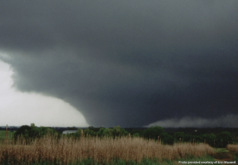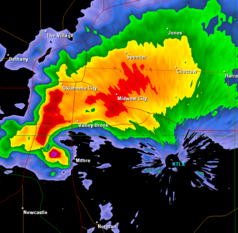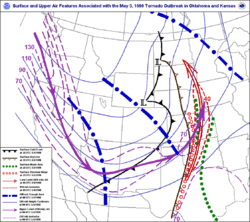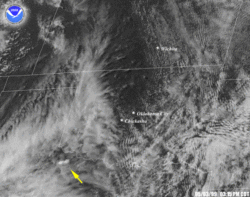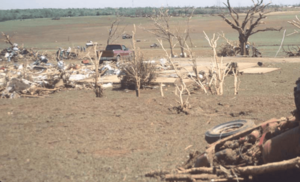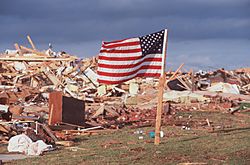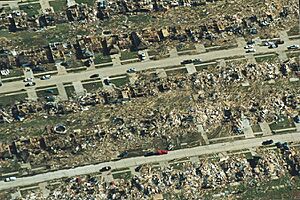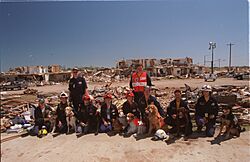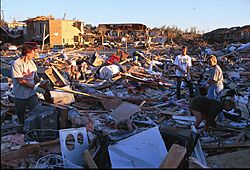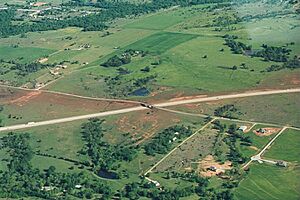1999 Bridge Creek–Moore tornado facts for kids
|
Top: View of the tornado near its peak intensity in Bridge Creek
Bottom: A radar image of the tornado on radar with a debris ball evident, as it approached the city of Moore |
|
| Meteorological history | |
|---|---|
| Duration | 1 hour, 25 minutes |
| Formed | May 3, 1999, 6:23 p.m. CDT (UTC−05:00) |
| Dissipated | May 3, 1999, 7:48 pm. CDT (UTC−05:00) |
| F5 tornado | |
| on the Fujita scale | |
| Highest winds | 321 mph (517 km/h) (as measured by mobile Doppler radar) |
| Overall effects | |
| Fatalities | 36 (+5 indirect) |
| Injuries | 583 |
| Damage | $1 billion (1999 USD) $1.8 billion (2025 USD) |
| Areas affected | Grady, McClain, Cleveland and Oklahoma counties in Oklahoma; with the worst impacts occurring in the towns/cities of Bridge Creek, Moore, Oklahoma City, Del City, and Midwest City |
|
Part of the 1999 Oklahoma tornado outbreak and Tornadoes of 1999 |
|
The 1999 Bridge Creek–Moore tornado was a very strong and long-lasting tornado that hit parts of Oklahoma on May 3, 1999. It was rated an F5 tornado, which is the highest level on the original Fujita scale. This tornado set a world record for the fastest wind speed ever measured on Earth, reaching 321 miles per hour (517 km/h). This measurement was taken by a special radar called Doppler On Wheels (DOW).
The tornado caused a lot of damage to southern Oklahoma City and nearby towns like Bridge Creek and Moore. It traveled for 38 miles (61 km) over 85 minutes. Thousands of homes were destroyed. Sadly, 36 people died directly from the tornado, and five more died from related causes. The damage cost about $1 billion (in 1999 money). This tornado was so serious that it led to the first-ever "tornado emergency" warning from the National Weather Service.
The tornado first touched down at 6:23 p.m. in Grady County, near Amber. It quickly grew stronger, becoming an F4, and then an F5 as it hit Bridge Creek. It changed strength a few times, from F2 to F5. It reached F5 strength again just before entering Moore. By 7:30 p.m., it moved into Oklahoma County, hitting parts of Oklahoma City, Del City, and Midwest City. It finally ended around 7:48 p.m. In total, over 8,000 homes and 1,000 apartments were damaged or destroyed. Many businesses and public buildings were also hit.
After the tornado, large rescue teams immediately started looking for people. The next day, President Bill Clinton declared it a major disaster, which allowed the state to get federal help. Over the next few months, about $67.8 million in aid was given. New building projects helped make the community safer from future tornadoes. However, on May 20, 2013, another very strong tornado, an EF5, hit some of the same areas. This 2013 tornado caused 24 deaths and huge damage.
Contents
How the Storm Formed
The Bridge Creek–Moore tornado was part of a much bigger event. On May 3, 1999, 71 tornadoes touched down across five states in the Great Plains. Oklahoma was hit the hardest, with 66 tornadoes. Many of these were very strong, like the Bridge Creek–Moore tornado.
On the morning of May 3, weather experts at the Storm Prediction Center (SPC) in Norman saw signs of bad weather. They noticed a "dry line" (where dry air meets moist air) moving towards warm, humid air over the Central Plains. This setup often creates thunderstorms with large hail, strong winds, and tornadoes.
At first, forecasters didn't fully realize how bad the storms would be. They later found out about a very fast jet stream high in the sky that they hadn't seen before. This strong wind made the conditions even more dangerous. By late morning, the SPC upgraded the risk for severe weather. They warned that conditions were right for "strong or violent tornadic supercells." A supercell is a powerful thunderstorm with a deep, rotating updraft.
By early afternoon, forecasters knew a major storm was coming. They saw that the air was very unstable. This meant warm air could rise quickly and create powerful thunderstorms. Even though there were some high clouds, clear skies in parts of Oklahoma allowed the sun to heat the ground, making the air even more unstable.
At 3:49 p.m., the SPC issued a "high risk" for severe weather. This meant there was a very high chance of strong tornadoes. About 40 minutes later, at 4:30 p.m., they issued a tornado watch for western and central Oklahoma. This watch warned of tornadoes, large hail, and strong winds. At the same time, the first thunderstorm of the day had already started forming in southwestern Oklahoma.
The Tornado's Path
How the Supercell Formed
The thunderstorm that created the F5 tornado started around 3:20 p.m. in Tillman County. It grew stronger as it moved northeast. By 4:15 p.m., the National Weather Service (NWS) in Norman issued a severe thunderstorm warning. Large hail began to fall.
As the storm's rotation grew stronger, a tornado warning was issued at 4:50 p.m. One minute later, a small tornado formed. This was the first of 14 tornadoes produced by this supercell. Several more tornadoes formed as the storm continued moving northeast. One of these was an F3 tornado that damaged the Chickasha Municipal Airport.
The Bridge Creek–Moore Tornado
At 6:23 p.m., the main tornado, the ninth one from this supercell, began near Amber. It quickly became very strong and wide. It reached F4 strength about 4 miles (6.4 km) east of Amber. It grew into a "wedge tornado," meaning it was very wide, sometimes up to one mile (1.6 km) across.
When it hit Bridge Creek, it became an F5, the highest rating. Here, a special mobile radar measured winds of 321 mph (517 km/h) inside the tornado. This is the fastest wind speed ever recorded on Earth.
The damage in Bridge Creek was extreme. Many homes were completely swept away, leaving only bare concrete. Trees and bushes lost all their bark. Cars were thrown hundreds of yards. Even one inch (25 mm) of asphalt was scraped off one road.
Twelve people died in Bridge Creek, mostly in mobile homes. Over 39 people were injured. The tornado then weakened slightly but quickly became an F5 again as it crossed into McClain County. It grew to one mile (1.6 km) wide. At this point, it became hard to see because it was wrapped in rain.
Around 6:57 p.m., the NWS Norman office issued the first-ever tornado emergency for southern Oklahoma City. This special warning was meant to tell people that a "rare and deadly tornado was imminent." Two minutes later, the SPC issued a "Particularly Dangerous Situation" tornado watch. This warned of a high threat of strong to violent tornadoes.
The tornado moved into McClain County, crossing I-44 twice. A smaller, weaker tornado also touched down nearby. In McClain County, 38 homes were destroyed, and 17 people were injured.
Tornado Hits Moore
After crossing the Canadian River, the tornado entered Cleveland County and weakened briefly. But it quickly became an F4 again, then an F5 as it moved into Moore. This was the third time it reached F5 strength.
Moore saw some of the worst damage. Eleven people died, and 293 were injured here. The tornado caused about $450 million in damage in Cleveland County. In one neighborhood, 50 homes were destroyed, and one was completely swept away. Cars were thrown almost 0.25 mi (0.40 km). An airplane wing, possibly from an airport hit earlier, was found near one neighborhood.
The tornado then hit the Greenbriar Eastlake Estates, killing three people and turning homes into rubble. Some homes were completely gone, leaving only concrete slabs. Three more people died at the Emerald Springs Apartments, where a two-story building was flattened.
The NWS Norman office prepared to evacuate in case the tornado turned towards them, but it continued northeast. People in Moore City Hall and at sporting events in Oklahoma City also took shelter. Flights were stopped at Will Rogers World Airport. Traffic on I-35 backed up as drivers tried to find shelter.
At Westmoore High School, an awards ceremony was happening. Thanks to early warnings, over 400 people moved to reinforced hallways and bathrooms. The school was heavily damaged, and cars in the parking lot were destroyed, but no one was hurt. The tornado continued through Moore, destroying many homes and killing four people near Janeway Avenue. It caused widespread F3 and F4 damage in the Highland Park neighborhood.
The tornado then entered Oklahoma County, hitting the edge of Oklahoma City. It became a high-end F4 again. Two people died as a trucking company building was destroyed. A freight train car weighing 36,000 pounds (16,000 kg) was thrown 0.75 miles (1.21 km). Many homes were destroyed, and one woman died in this area.
Crossing into Del City, the tornado hit the Del Aire housing area. Six people died, and hundreds of homes were damaged or destroyed. The tornado then damaged Tinker Air Force Base and hit Midwest City. It destroyed a building at the Boeing Complex and damaged others.
Widespread F3/F4 damage continued as the tornado crossed I-40, hitting a large business area. About 800 cars at Hudiburg Auto Group were damaged. Dozens of cars were picked up and thrown across the interstate into motels. Many motels and businesses, including parts of Rose State College, were destroyed. The damage here was almost F5. The tornado then moved into a residential area, where three more people died. Four homes here had high-end F4 damage. The tornado then quickly weakened and ended between Sooner Road and Air Depot Boulevard. In Oklahoma County, 12 people died, and 234 were injured. The total cost of damage was $450 million.
Impact and What Happened Next
In total, 36 people died directly from the tornado, and five more died from related issues. About 583 people were injured. Over 8,000 homes, 1,000 apartments, and 260 businesses were damaged or destroyed. The total cost of damage was about $1.2 billion. This was the first tornado ever to cause over $1 billion in damage.
This tornado was the deadliest in Oklahoma since 1947. It was also the deadliest tornado ever in the Oklahoma City area. It was the most expensive tornado in U.S. history until 2011. Experts believe that many more people would have died if it weren't for the early warnings from local TV and radio stations. Oklahoma City TV stations are very good at tracking severe weather and giving warnings. They also teach people how to prepare for tornadoes.
Aftermath and Recovery
After the tornadoes, President Bill Clinton declared a major disaster for eleven Oklahoma counties on May 4. This allowed federal help to come in. The American Red Cross opened shelters for people who lost their homes. Teams from the Federal Emergency Management Agency (FEMA) came to help with emergency response and damage assessment. The U.S. Department of Defense and other groups sent help.
Search and rescue efforts continued for days. Nearly 1,000 members of the Oklahoma National Guard helped in the affected areas. Donation centers and phone lines were set up to raise money for victims. A disaster recovery center opened in Moore. Experts estimated that about 500,000 cubic yards of debris needed to be cleared.
Debris removal began on May 12. FEMA also announced that more counties could get federal financial help. By May 13, about $1.6 million in disaster funds had been approved. This amount quickly grew. By May 21, over 3,000 volunteers came to Oklahoma to help. They cleaned up debris, cut trees, and cooked meals. A special program was set up to help victims with stress from the tornado.
Applications for federal aid continued through June. By June 3, about $54 million had been approved. Most of the debris had been removed. Aid was also available for farmers and ranchers. Emergency shelters closed in June. FEMA encouraged residents to build storm cellars. In total, about $67.8 million in disaster aid was given out.
Over the next four years, a $12 million project built storm shelters for residents in the Oklahoma City area. The goal was to make the community safer. By May 2003, over 6,000 safe rooms were built. This new safety plan was tested on May 9, 2003, when another F4 tornado followed a similar path. Because of the better safety measures, no one died in the 2003 tornado. However, on May 20, 2013, an EF5 tornado hit some of the same areas in Moore. This tornado killed 24 people and injured many more.
Why Highway Overpasses Are Not Safe
This tornado also taught an important lesson about safety. Before 1999, some people thought highway overpasses were safe places to hide from tornadoes. This idea came from videos where people survived under an overpass during a weaker tornado in 1991. However, meteorologists had always warned that overpasses were dangerous.
The May 1999 tornado outbreak proved these warnings were true. Three overpasses were directly hit by tornadoes, and one person died at each one. Many others were seriously injured. This happens because of the Venturi effect. When a tornado passes through an overpass, the wind speeds up in the small space. This can blow people out at high speeds, even if they try to hold on. Experts say that hiding under an overpass means you become an easy target for flying debris.
Building Stronger Homes
After the tornado, experts from Texas Tech University studied the damage. They found that many homes destroyed by the tornado were not built strongly enough. They discovered problems that went against basic building codes. For example, nails in roofs were not properly attached, and some homes were not bolted to their foundations. This meant they couldn't withstand strong winds.
The experts also saw that some homes were destroyed even before the tornado's strongest winds hit them. This happened because the winds around the main tornado were already very strong. Three months later, as new homes were being built, the experts found that they were still not much stronger than the ones destroyed.
FEMA agreed with these findings. Their report said that much of the damage was because buildings were not designed to handle such strong winds and flying debris. They also noted that poor building methods and materials were used. The report suggested that building codes needed to be updated. Newer buildings should be able to withstand stronger winds. This would help reduce damage, deaths, and injuries in future tornadoes.
See also
- List of North American tornadoes and tornado outbreaks
- List of tornadoes with confirmed satellite tornadoes
- List of tornadoes in the 1999 Oklahoma tornado outbreak
- 2003 Moore–Choctaw tornado
- 2011 El Reno–Piedmont tornado
- 2013 Moore tornado
- 2013 El Reno tornado
- List of Cleveland County, Oklahoma tornadoes
| Preceded by Wichita Falls, TX (1979) |
Costliest U.S. tornadoes on Record May 3, 1999 |
Succeeded by Tuscaloosa–Birmingham, AL (2011) |


